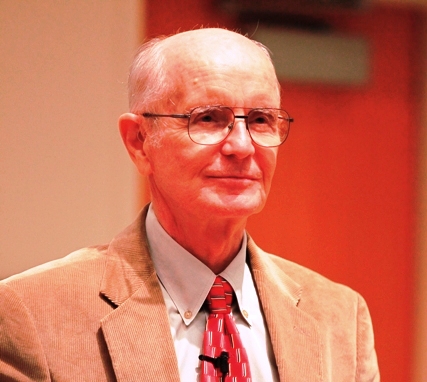Marlan O. Scully is honored for Quantum Optics Research

Marlan O. Scully, Ph.D.
Follow us on Twitter:@BaylorUMediaCom
Media Contact: Frank Raczkiewicz, (254) 710-1964
WACO, Texas (Sept. 18, 2012) - Marlan O. Scully, Ph.D., Baylor University Distinguished Researcher and member of the National Academy of Sciences, has been named as the 2012 recipient of the Frederic Ives Medal/Jarus Quinn Prize, the highest award conferred by The Optical Society for his groundbreaking research in quantum optics.
He will accept the medal and give the plenary speech entitled, "The Quantum Photocell: Increasing Efficiency via Quantum Coherence," at the OSA's annual meeting Oct. 14 to 18 in Rochester, N.Y.
"Dr. Scully is a prolific scholar and researcher, and he has made countless contributions to the field of quantum optics," said Elizabeth Davis, Ph.D., Baylor University executive vice president and provost. "This award is well-deserved recognition for his lifetime of achievements. We are delighted to have Dr. Scully as a member of the faculty here at Baylor."
Scully was cited for his lifetime of leadership in "research on all aspects of quantum optics, including the quantum theory of the laser, quantum coherence effects, quantum thermodynamics and the foundations of quantum mechanics," according to the OSA.
"A man may plot his course, but the Lord orders his steps, and looking back at the path He has laid for me in this life is humbling," Scully said. "Quantum mechanics, the crowning achievement of the 20th century, continues to bear fruit in the 21st century in the form of quantum optics and laser physics. The OSA has consistently nurtured quantum optics and is my favorite professional society. I am therefore deeply honored to receive the Ives-Quinn prize of the OSA."
Scully, who joined the Baylor faculty in 2011, has made outstanding research accomplishments over his long career in the areas of quantum optics, laser physics and bioengineering. He wrote definitive textbooks on quantum optics and laser physics and has published his research in more than 700 articles in professional journals such as Nature and Science. He has also written for popular venues like Scientific American and Physics Today.
"Dr. Scully continues to push back the boundaries of physics while at the same time opening entirely new areas of research in quantum optics. His presence in the BRIC provides immediate international impact and opens the door to wonderful opportunities in the future. This award is richly deserved and we are fortunate to have him as part of the Baylor family," said Truell Hyde, Ph.D., Baylor University vice provost for research.
Scully is a member of the Academia Europa, the Max Planck Society, and the American Academy of Arts and Sciences. He has received numerous awards and honors including the Elliot Cresson Medal of the Franklin Institute, the Schawlow Prize of the American Physical Society, the Townes Medal of the American Optical Society, the Herbert Walther Award of the German Physical Society, and a Guggenheim Fellowship. He was recently appointed Loeb Lecturer at Harvard University.
Scully did his undergraduate work at the University of Wyoming and Rensselaer Polytechnic Institute and his master's and doctoral work at Yale University. He is also a member of the faculties at Texas A&M University and Princeton University. He is the Herschel Burgess Distinguished Professor and Director of the Institute for Quantum Science and Engineering at Texas A&M and for the past decade has held a professorial position at Princeton.
The Optical Society (OSA) brings together the global optics community through its programs and initiatives. Since 1916 it has worked to advance the common interests of the field, providing educational resources to the scientists, engineers and business leaders who work in the field by promoting the science of light and the advanced technologies made possible by optics and photonics. OSA publications, events, technical groups and programs foster optics knowledge and scientific collaboration among all those with an interest in optics and photonics. For more information, visit www.osa.org.
ABOUT BAYLOR
Baylor University is a private Christian university and a nationally ranked research institution, characterized as having "high research activity" by the Carnegie Foundation for the Advancement of Teaching. The university provides a vibrant campus community for approximately 15,000 students by blending interdisciplinary research with an international reputation for educational excellence and a faculty commitment to teaching and scholarship. Chartered in 1845 by the Republic of Texas through the efforts of Baptist pioneers, Baylor is the oldest continually operating university in Texas. Located in Waco, Baylor welcomes students from all 50 states and more than 80 countries to study a broad range of degrees among its 11 nationally recognized academic divisions. Baylor sponsors 19 varsity athletic teams and is a founding member of the Big 12 Conference.
ABOUT BRIC
The Baylor Research and Innovation Collaborative, (BRIC), is the first, and cornerstone, facility of the 21-acre Central Texas Technology and Research Park. When completed and fully occupied the 330,000 sq. foot building will house Baylor University research, university and industry research collaborations, technology workforce development and training, a business accelerator, space for start-up businesses, symposia meeting venues for up to 300 attendees, and K-12 science, technology, engineering and math (STEM) outreach programs. Local government and community partners for the BRIC include Baylor University, Bellmead Economic Development Corporation, City of Bellmead, City of Waco, Cooper Foundation, Greater Waco Chamber of Commerce, McLennan County, Texas State Technical College, Waco-McLennan County Economic Development Corporation and Waco Industrial Foundation. The first 45,000 square feet are scheduled to be occupied in the spring of 2013.